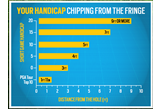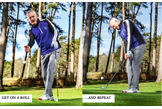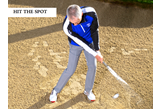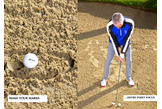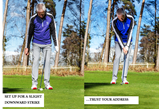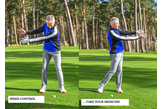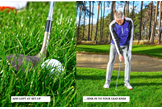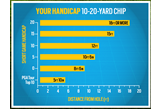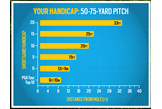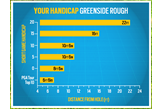What is your short game handicap?
Published:
We all gauge our all-round game by our handicap – and we can do the same just for our short game. Here’s how, plus some simple tips and drills to improve yours…
In allowing competitive games between all levels of player, golf’s handicapping system may just be one of sport’s finest conceptions. It does, however, have one major drawback; it hides your strengths and weaknesses. Your scores are, of course, made up of long game and short game shots, and your resultant handicap is inevitably a blend of the two. But few golfers are equally adept in both areas; most of us are held back by one or the other.
If you could discover what sort of handicap your short game performance equates to, you would find out which… and then adjust your focus and practice time accordingly. But this feature goes a step further. In breaking down your short game handicap into five common situations, this process will help you discover which shots you’re good at, and which ones need work.
So even if you discover your short game is the stronger part of your play, you can take the necessary steps to make it even better. Here, European Tour winner and short game expert Andrew Murray shows you how, with just five balls and a tape measure, you can discover your own short game handicap. And with simple, effective tips on each of the five shots, you will end the process with a clear picture not just of the state of your short game, but how to set about improving it.

The five shots
To get a true picture of the quality of your chipping, pitching and bunker play, we are removing putting from the equation. As a consequence, your short game handicap will be based not on scoring, but on average proximity to the hole from five common short game situations: (click on each link to jump to that section of the article)
1. Chip from the fringe
2. 10-20-yard shot
3. 50-75-yard shot
4. Shots under 30 yards from rough
5. Greenside bunker shot
6. Putting it all together: Work out your short game handicap
Delivering your handicap
As a basis for assigning an average proximity to a handicap, we used stats from the PGA Tour. In averaging out the proximity for the top 10 in each category, we can arrive at a figure that equates to the best of the best, whose handicaps are typically at the +5 or +6 level. We can then work back to give a suggested proximity for each handicap level, right down to 20.
***
Shot #1: Chipping from the fringe
Your first shot is also the simplest – a straightforward, shortish chip from the green fringe, at an average distance of around five yards.

● Feel free to practise first… but when you are ready, gather five balls and chip them towards the hole. For each shot, measure the distance from the hole in feet and inches. After you’ve measured the fifth shot, add up the total proximity and divide it by five to give yourself an average.
● Ideally, use the make of ball you’d usually use when you play.
● For more accurate results, vary the shot – by chipping to different pins or chipping from different fringe locations. But give yourself a decent lie and keep the average distance of the shot at around five yards.
Below, follow these this drill to improve your fringe chipping to find the right back and attack angle.
Drill 1
Get on a roll:
One of the most effective ways to improve short chips is to roll a ball to the hole with your trail hand. When you do this, you naturally set your lead foot in a flared position that encourages the pelvis to open up and clear. That creates the space and movement to help the arm and ball release through to the hole.
… and repeat
It’s really a very similar motion with the golf club. Flare that lead foot and work on that same underarm roll motion with the golf club; as you swing down, help that lead hip clear and feel how this movement pulls the hands, arms and club down the line and through towards the flag.

Drill 2
Set Up A Slight Downward Strike
Ideal attack angle for a fringe chip is just slightly down; an element of squeeze is good, but it does not need exaggerating. Play the ball centrally and feel 65 per cent of your weight under your lead foot. Place the clubhead behind the ball and lean shaft on your lead thigh to set up the ideal shaft lean.
Trust Your Address
Those set-up changes are all you need to create that subtle downward attack. Just keep your weight anchored on your front foot and swing the club back and through, trusting loft to pop the ball up and forwards. The sole of the club might brush the grass, but not steeply enough to break the surface.

Shot #2: The 10-20 Yard Chip
Your second challenge sees the kind of longer chip shot we often face having missed the green – an average of around 15 yards from the hole. The very best in the world average under 6ft from this distance… but how good are you?
The process is exactly the same as with the fringe chip – a little practice first, before five “live” shots, again ideally from different locations or to different targets, before measuring your results and dividing by five to get an average proximity. You can go as short as 10 yards or as long as 20, but try to keep the average around 15 yards.

Note: As the shot changes, don’t be afraid to change clubs. A great short game means a honed instinct for selecting the club that delivers the most effective carry/run-out ratio for the shot you are playing. The more you can practise this, the better you’ll get.
Drill No.1
Think Forwards, Not Upwards
One of the most common errors we see with club golfers from this range is trying to help the ball up. As with the fringe chip, an underarm throw is a great way to understand both the problem and the solution. See here how, when you throw the ball upwards, your weight and head fall back; it’s a scooping release that adds unwanted loft to the face and causes du s and thins.
Level Throw
Practise a throw that sees the ball come out level with the hand. When you do this you get a much more effective weight shift and release pattern, one that promotes a cleaner and more level attack when used with a golf club… plus the ability to apply the club’s true loft to the ball. As with the throw, your whole mindset should be based around sending the ball forwards, not upwards.

Drill No.2
Use The Sole
A true bene t of this more level-strike motion is that it allows you to use the curved sole of the club, or the bounce. An anti-du design, the bounce works by raising the sharp, digging leading edge of the club away from the turf. A level or again slightly downward attack angle allows you to ‘bruise’ the turf with the back edge of the sole. Use the flagstick to help you feel this.
Hit The Pin
Rest the head of your wedge on the flagstick with neutral shaft lean; you should feel it’s the back edge of the sole that’s in contact with the pin. Now swing up and down the flag, allowing the sole of the club to “bounce” off it. Feel how this promotes a smooth, level attack. Finish your action “in balance”, arms extended and the butt of the club pointing back to your stomach.

Shot #3: 50-75 Yard Pitch
Now we come to the longest part of the test – pitch shots between 50 and 75 yards. As before, hit five balls and work out your average proximity. But with a 25-yard range in distance, this particular challenge gives you the most scope to treat each shot separately.
Feel free to use that full 50-75-yard range, treating each shot as a unique test just as you find on the course. But within this, try to keep your average shot distance somewhere close to the middle of the range at around 60-65 yards.
Picture This: Imagination and creativity are part of every top-class short game, so in selecting your five efforts be creative – use trees and hazards to help you frame a specific picture of the shot to come, and then choose the club that can deliver on your vision.
Drill 1
Speed Control
As a chip turns into a pitch, we introduce wrist action. This adds clubhead speed, but that speed needs to be metered if you are to control the shot. The best way to do that is to ensure your core is making a contribution to your action; when bigger muscles dictate the pace of your action, it’s easier to harness the pace of the club.
Take Your Medicine
To train that core contribution, set up without a club, palms facing each other as if holding a medicine ball. Swing back and through, feeling your arms and body turn working in harmony, chest facing hands throughout. When this even-paced, back/ through action feels comfortable, take your wedge and repeat it with the ball.

Drill 2
Get Forward
It’s important your lower body action backs up that “medicine ball-throw” swing. If you’re at-footed and static, your hips and chest can’t pivot properly and you will end up flicking at the ball. Even though this is a short shot, you still need to get o your back foot. Here is a simple thought to help.
Pocket to Target
To engage your lower half, hit pitches focusing on the scorecard pocket behind your trail glute. As you swing through, practise the feeling of allowing that pocket to turn through to the target. That will help you find this much more effective finish position, both upper and lower zips facing the target and up on your trail toe.

Shot #4: The GreenSide Shot From Rough
Naturally, any true evaluation of your short game needs to include your performance from greenside rough. The routine is the same as before – five shots, five proximity distances measured and averaged. But here it is more important than ever to represent the variety of the golf course by mixing up the lies and stances. Drop each ball, don’t place it, and change the overall shot distances.
The PGA Tour stats account for any shot within 30 yards of the green, so add in a shorter and a longer shot alongside three shots of around 15-20 yards.

Reading the lie: As you test your rough play it’s important you hit from a variety of lies, some good, some nestled, just as you would experience on the course. Improving your rough play is also about sharpening your ability to read the lie and interpret how the ball will react o the face. If you are constantly ‘teeing the ball up’ for yourself in the long grass, you can’t learn this vital skill… and you’ll get a skewed picture of how good you are.
Four things to do: Soften the face and sharpen attack angle to improve your shots from the greenside rough
1. Add Loft At Set-Up
From rough, the grass can grab the hosel and twist the face shut, while the lack of spin means more run-out. Both factors increase the demand to create and maintain loft on the face. So at set-up, rotate the handle to open the face and add a few extra degrees. This softened face aids a higher flight, a softer landing and more control.
2. Sink In To Your Lead Knee
Because of the tangly long grass behind the ball, you’ll need to employ a steeper angle of attack than usual to minimise grass trapped between the face and ball and find an effective strike. Create this angle by playing the ball just back of centre and sinking your weight into your lead thigh knee. Both promote that downward strike.

3. Hit Down… With Loft
Maintain pressure down through your lead leg right through to impact. It anchors the low point of the swing ahead of the ball, helping you deliver that steeper downward strike. This, coupled with the extra clubface loft, helps create this unusual impact where the ball rises sharply o the blade, despite the downward angle of attack.
4. Clubface Faces The sky
Make it your mission to finish this short swing with the grooves of your wedge looking up at the sky. This intention helps you retain clubface loft through the hitting zone, and resist the common problem of the rough trying to twist the face shut. Adding a little extra grip pressure can help you achieve this goal.

Shot #5: The GreenSide Bunker Shot
Of course short game bunker shots can range from five yards right up to 50 or 60, but for short game handicap purposes keep your five shots at or around the most typical distance of 10 yards. As with the previous four shots, hit five balls, measure each and divide by five to get a proximity average. Only measure shots that find the green.
As the figures show, the top tour players get this shot pretty close as a matter of course… but performance falls off pretty dramatically as the handicap climbs. While for most golfers three from sand is never a bad result, if you can start throwing in a few more up-and-downs your scores can really benefit.

Trail focus: While your sole objective on those five balls is to hit them as close as possible, bear in mind that in sand you are always looking to engage the back edge of the club with the sand and not the leading edge. This one thought can help you find the generally shallow attack angle that leads to effective sand contact – and better results.
Improve your bunker play: Use the amount of sand to control the distance
There are different schools of thought on bunker play, but I’m a big believer in keeping things simple. That means keeping your stance and swing generally the same on all shots, but adjusting the amount of sand you take to control distance. Improving your sand play, then, is all about honing your ability to splash the appropriate parcel of sand on to the green. Here is a simple process to help.
Make your marks
Draw an oval in the sand, around six inches long, and place the ball in the middle of it. Using the ball, make two depressions in the sand behind the ball. These marks represent two entry points for the clubhead; the first, closer to the ball, means less sand taken and is for longer trap shots; the second, with more sand, is for shorter shots.
Entry Point Focus
Take your sand wedge and address the ball. Position it centrally in your stance and open the clubface slightly to increase loft and sole bounce. Fix your eyes on the ball mark you intend to hit, and hover the leading edge of the club over it.

Hit The Spot
Your sole focus now is to strike your chosen spot with the sole of your sand wedge. Make a series of swings, switching between the two. As you do this, your skill in taking your chosen amount of sand will grow… and so will your ability to control the distance the ball goes.
Lost The Drift
This is not a techy drill, but you will improve your ability to hit your chosen mark when you avoid lateral movement during your swing. Lock your weight into your lead side at address and make sure it stays there right through to the finish; watch the top players and you’ll see their lead knee holds its position throughout.

Putting it all together: Work out your short game handicap
If you’ve done all these tests, by now you should have five average proximity scores. Now, just add them together to get an overall total. Where does that sit on the following chart?

Almost certainly your total feet- and-inches gure falls between these guidelines… but these references should be enough to allow you to give your total a handicap equivalent.
If it is higher than your playing handicap, your short game is holding your score back; if it is lower, it suggests your long game needs more work.
But either way, look through your five individual totals and isolate the worst one; working on this is the quickest route to lower scores.


